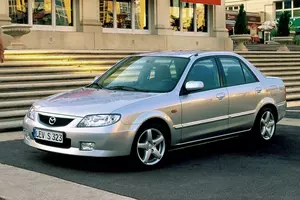
| Vehicle | Curb weight | Difference from world's smallest | Weight to power ratio | 0—60 mph acceleration ratio | Consumption ratio |
|---|---|---|---|---|---|
| 2.0i 16V |
1155 kg / 2547 lbs |
730 kg (1610 lbs) heavier | 9 kg to 1 hp | 126 kg/s (278 lbs/s) |
136 kg/L (300 lbs/L) |
| 1.8i 16V |
1125 kg / 2481 lbs |
700 kg (1544 lbs) heavier | 10 kg to 1 hp | 121 kg/s (267 lbs/s) | - |
| 1.5 i 16V |
1065 kg / 2348 lbs |
640 kg (1411 lbs) heavier | 12 kg to 1 hp | 94 kg/s (207 lbs/s) | - |
| 1.6 i 16V |
1095 kg / 2414 lbs |
670 kg (1477 lbs) heavier | 11 kg to 1 hp | 100 kg/s (221 lbs/s) |
146 kg/L (322 lbs/L) |
| 1.3 i 16V |
1055 kg / 2326 lbs |
630 kg (1389 lbs) heavier | 14 kg to 1 hp | 78 kg/s (172 lbs/s) |
143 kg/L (315 lbs/L) |
| 2.0 D |
1135 kg / 2503 lbs |
710 kg (1566 lbs) heavier | 16 kg to 1 hp | 70 kg/s (154 lbs/s) | - |
| 2.0 DiTD |
1160 kg / 2558 lbs |
735 kg (1621 lbs) heavier | 13 kg to 1 hp | 100 kg/s (221 lbs/s) | - |
| Vehicle | 2.0i 16V |
|---|---|
| Curb weight |
1155 kg / 2547 lbs |
| Difference from world's smallest | 730 kg (730 lbs) heavier |
| Weight to power ratio | 9 kg to 1 hp |
| 0—60 mph acceleration ratio | 126 kg/s (278 lbs/s) |
| Consumption ratio |
136 kg/L (300 lbs/L) |
| Vehicle | 1.8i 16V |
| Curb weight |
1125 kg / 2481 lbs |
| Difference from world's smallest | 700 kg (700 lbs) heavier |
| Weight to power ratio | 10 kg to 1 hp |
| 0—60 mph acceleration ratio | 121 kg/s (267 lbs/s) |
| Consumption ratio | - |
| Vehicle | 1.5 i 16V |
| Curb weight |
1065 kg / 2348 lbs |
| Difference from world's smallest | 640 kg (640 lbs) heavier |
| Weight to power ratio | 12 kg to 1 hp |
| 0—60 mph acceleration ratio | 94 kg/s (207 lbs/s) |
| Consumption ratio | - |
| Vehicle | 1.6 i 16V |
| Curb weight |
1095 kg / 2414 lbs |
| Difference from world's smallest | 670 kg (670 lbs) heavier |
| Weight to power ratio | 11 kg to 1 hp |
| 0—60 mph acceleration ratio | 100 kg/s (221 lbs/s) |
| Consumption ratio |
146 kg/L (322 lbs/L) |
| Vehicle | 1.3 i 16V |
| Curb weight |
1055 kg / 2326 lbs |
| Difference from world's smallest | 630 kg (630 lbs) heavier |
| Weight to power ratio | 14 kg to 1 hp |
| 0—60 mph acceleration ratio | 78 kg/s (172 lbs/s) |
| Consumption ratio |
143 kg/L (315 lbs/L) |
| Vehicle | 2.0 D |
| Curb weight |
1135 kg / 2503 lbs |
| Difference from world's smallest | 710 kg (710 lbs) heavier |
| Weight to power ratio | 16 kg to 1 hp |
| 0—60 mph acceleration ratio | 70 kg/s (154 lbs/s) |
| Consumption ratio | - |
| Vehicle | 2.0 DiTD |
| Curb weight |
1160 kg / 2558 lbs |
| Difference from world's smallest | 735 kg (735 lbs) heavier |
| Weight to power ratio | 13 kg to 1 hp |
| 0—60 mph acceleration ratio | 100 kg/s (221 lbs/s) |
| Consumption ratio | - |

| Vehicle | Curb weight | Difference from world's smallest | Weight to power ratio | 0—60 mph acceleration ratio | Consumption ratio |
|---|---|---|---|---|---|
| Sport 2.0i 16V |
1185 kg / 2613 lbs |
760 kg (1676 lbs) heavier | 9 kg to 1 hp | 129 kg/s (284 lbs/s) |
139 kg/L (306 lbs/L) |
| 1.3 i 16V |
1070 kg / 2359 lbs |
645 kg (1422 lbs) heavier | 15 kg to 1 hp | 79 kg/s (174 lbs/s) |
145 kg/L (320 lbs/L) |
| 1.6 i 16V |
1070 kg / 2359 lbs |
645 kg (1422 lbs) heavier | 11 kg to 1 hp | 97 kg/s (214 lbs/s) |
145 kg/L (320 lbs/L) |
| 1.5 i 16V |
1115 kg / 2459 lbs |
690 kg (1522 lbs) heavier | 13 kg to 1 hp | 99 kg/s (218 lbs/s) | - |
| 2.0 DiTD |
1175 kg / 2591 lbs |
750 kg (1654 lbs) heavier | 13 kg to 1 hp | 101 kg/s (223 lbs/s) | - |
| 1.8 i 16V |
1115 kg / 2459 lbs |
690 kg (1522 lbs) heavier | 10 kg to 1 hp | 108 kg/s (238 lbs/s) | - |
| 2.0 D |
1150 kg / 2536 lbs |
725 kg (1599 lbs) heavier | 16 kg to 1 hp | 71 kg/s (157 lbs/s) | - |
| Vehicle | Sport 2.0i 16V |
|---|---|
| Curb weight |
1185 kg / 2613 lbs |
| Difference from world's smallest | 760 kg (760 lbs) heavier |
| Weight to power ratio | 9 kg to 1 hp |
| 0—60 mph acceleration ratio | 129 kg/s (284 lbs/s) |
| Consumption ratio |
139 kg/L (306 lbs/L) |
| Vehicle | 1.3 i 16V |
| Curb weight |
1070 kg / 2359 lbs |
| Difference from world's smallest | 645 kg (645 lbs) heavier |
| Weight to power ratio | 15 kg to 1 hp |
| 0—60 mph acceleration ratio | 79 kg/s (174 lbs/s) |
| Consumption ratio |
145 kg/L (320 lbs/L) |
| Vehicle | 1.6 i 16V |
| Curb weight |
1070 kg / 2359 lbs |
| Difference from world's smallest | 645 kg (645 lbs) heavier |
| Weight to power ratio | 11 kg to 1 hp |
| 0—60 mph acceleration ratio | 97 kg/s (214 lbs/s) |
| Consumption ratio |
145 kg/L (320 lbs/L) |
| Vehicle | 1.5 i 16V |
| Curb weight |
1115 kg / 2459 lbs |
| Difference from world's smallest | 690 kg (690 lbs) heavier |
| Weight to power ratio | 13 kg to 1 hp |
| 0—60 mph acceleration ratio | 99 kg/s (218 lbs/s) |
| Consumption ratio | - |
| Vehicle | 2.0 DiTD |
| Curb weight |
1175 kg / 2591 lbs |
| Difference from world's smallest | 750 kg (750 lbs) heavier |
| Weight to power ratio | 13 kg to 1 hp |
| 0—60 mph acceleration ratio | 101 kg/s (223 lbs/s) |
| Consumption ratio | - |
| Vehicle | 1.8 i 16V |
| Curb weight |
1115 kg / 2459 lbs |
| Difference from world's smallest | 690 kg (690 lbs) heavier |
| Weight to power ratio | 10 kg to 1 hp |
| 0—60 mph acceleration ratio | 108 kg/s (238 lbs/s) |
| Consumption ratio | - |
| Vehicle | 2.0 D |
| Curb weight |
1150 kg / 2536 lbs |
| Difference from world's smallest | 725 kg (725 lbs) heavier |
| Weight to power ratio | 16 kg to 1 hp |
| 0—60 mph acceleration ratio | 71 kg/s (157 lbs/s) |
| Consumption ratio | - |
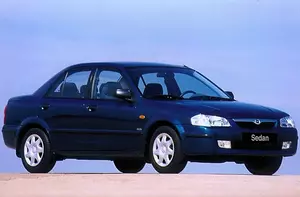
| Vehicle | Curb weight | Difference from world's smallest | Weight to power ratio | 0—60 mph acceleration ratio | Consumption ratio |
|---|---|---|---|---|---|
| 1.3 i 16V |
980 kg / 2161 lbs |
555 kg (1224 lbs) heavier | 13 kg to 1 hp | 78 kg/s (172 lbs/s) | - |
| 2.0 D |
1170 kg / 2580 lbs |
745 kg (1643 lbs) heavier | 16 kg to 1 hp | 87 kg/s (192 lbs/s) | - |
| 1.5 i 16V |
1020 kg / 2249 lbs |
595 kg (1312 lbs) heavier | 12 kg to 1 hp | 91 kg/s (201 lbs/s) | - |
| Vehicle | 1.3 i 16V |
|---|---|
| Curb weight |
980 kg / 2161 lbs |
| Difference from world's smallest | 555 kg (555 lbs) heavier |
| Weight to power ratio | 13 kg to 1 hp |
| 0—60 mph acceleration ratio | 78 kg/s (172 lbs/s) |
| Consumption ratio | - |
| Vehicle | 2.0 D |
| Curb weight |
1170 kg / 2580 lbs |
| Difference from world's smallest | 745 kg (745 lbs) heavier |
| Weight to power ratio | 16 kg to 1 hp |
| 0—60 mph acceleration ratio | 87 kg/s (192 lbs/s) |
| Consumption ratio | - |
| Vehicle | 1.5 i 16V |
| Curb weight |
1020 kg / 2249 lbs |
| Difference from world's smallest | 595 kg (595 lbs) heavier |
| Weight to power ratio | 12 kg to 1 hp |
| 0—60 mph acceleration ratio | 91 kg/s (201 lbs/s) |
| Consumption ratio | - |
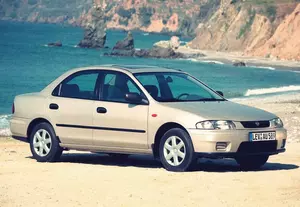
| Vehicle | Curb weight | Difference from world's smallest | Weight to power ratio | 0—60 mph acceleration ratio | Consumption ratio |
|---|---|---|---|---|---|
| 1.3 i 16V |
1040 kg / 2293 lbs |
615 kg (1356 lbs) heavier | 14 kg to 1 hp | 82 kg/s (181 lbs/s) |
142 kg/L (313 lbs/L) |
| 1.7 TD |
1170 kg / 2580 lbs |
745 kg (1643 lbs) heavier | 14 kg to 1 hp | 87 kg/s (192 lbs/s) |
186 kg/L (410 lbs/L) |
| 1.5i 16V |
1070 kg / 2359 lbs |
645 kg (1422 lbs) heavier | 12 kg to 1 hp | 94 kg/s (207 lbs/s) |
149 kg/L (329 lbs/L) |
| 1.8i 16V |
1125 kg / 2481 lbs |
700 kg (1544 lbs) heavier | 10 kg to 1 hp | 121 kg/s (267 lbs/s) |
142 kg/L (313 lbs/L) |
| 2.0 D |
1230 kg / 2712 lbs |
805 kg (1775 lbs) heavier | 17 kg to 1 hp | 90 kg/s (198 lbs/s) | - |
| Vehicle | 1.3 i 16V |
|---|---|
| Curb weight |
1040 kg / 2293 lbs |
| Difference from world's smallest | 615 kg (615 lbs) heavier |
| Weight to power ratio | 14 kg to 1 hp |
| 0—60 mph acceleration ratio | 82 kg/s (181 lbs/s) |
| Consumption ratio |
142 kg/L (313 lbs/L) |
| Vehicle | 1.7 TD |
| Curb weight |
1170 kg / 2580 lbs |
| Difference from world's smallest | 745 kg (745 lbs) heavier |
| Weight to power ratio | 14 kg to 1 hp |
| 0—60 mph acceleration ratio | 87 kg/s (192 lbs/s) |
| Consumption ratio |
186 kg/L (410 lbs/L) |
| Vehicle | 1.5i 16V |
| Curb weight |
1070 kg / 2359 lbs |
| Difference from world's smallest | 645 kg (645 lbs) heavier |
| Weight to power ratio | 12 kg to 1 hp |
| 0—60 mph acceleration ratio | 94 kg/s (207 lbs/s) |
| Consumption ratio |
149 kg/L (329 lbs/L) |
| Vehicle | 1.8i 16V |
| Curb weight |
1125 kg / 2481 lbs |
| Difference from world's smallest | 700 kg (700 lbs) heavier |
| Weight to power ratio | 10 kg to 1 hp |
| 0—60 mph acceleration ratio | 121 kg/s (267 lbs/s) |
| Consumption ratio |
142 kg/L (313 lbs/L) |
| Vehicle | 2.0 D |
| Curb weight |
1230 kg / 2712 lbs |
| Difference from world's smallest | 805 kg (805 lbs) heavier |
| Weight to power ratio | 17 kg to 1 hp |
| 0—60 mph acceleration ratio | 90 kg/s (198 lbs/s) |
| Consumption ratio | - |

| Vehicle | Curb weight | Difference from world's smallest | Weight to power ratio | 0—60 mph acceleration ratio | Consumption ratio |
|---|---|---|---|---|---|
| 1.5 i 16V |
1115 kg / 2459 lbs |
690 kg (1522 lbs) heavier | 13 kg to 1 hp | 98 kg/s (216 lbs/s) |
155 kg/L (342 lbs/L) |
| 1.8i 16V |
1115 kg / 2459 lbs |
690 kg (1522 lbs) heavier | 10 kg to 1 hp | - |
139 kg/L (306 lbs/L) |
| 2.0i V6 24V |
1210 kg / 2668 lbs |
785 kg (1731 lbs) heavier | 8 kg to 1 hp | 149 kg/s (329 lbs/s) |
136 kg/L (300 lbs/L) |
| Vehicle | 1.5 i 16V |
|---|---|
| Curb weight |
1115 kg / 2459 lbs |
| Difference from world's smallest | 690 kg (690 lbs) heavier |
| Weight to power ratio | 13 kg to 1 hp |
| 0—60 mph acceleration ratio | 98 kg/s (216 lbs/s) |
| Consumption ratio |
155 kg/L (342 lbs/L) |
| Vehicle | 1.8i 16V |
| Curb weight |
1115 kg / 2459 lbs |
| Difference from world's smallest | 690 kg (690 lbs) heavier |
| Weight to power ratio | 10 kg to 1 hp |
| 0—60 mph acceleration ratio | - |
| Consumption ratio |
139 kg/L (306 lbs/L) |
| Vehicle | 2.0i V6 24V |
| Curb weight |
1210 kg / 2668 lbs |
| Difference from world's smallest | 785 kg (785 lbs) heavier |
| Weight to power ratio | 8 kg to 1 hp |
| 0—60 mph acceleration ratio | 149 kg/s (329 lbs/s) |
| Consumption ratio |
136 kg/L (300 lbs/L) |
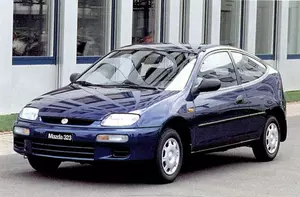
| Vehicle | Curb weight | Difference from world's smallest | Weight to power ratio | 0—60 mph acceleration ratio | Consumption ratio |
|---|---|---|---|---|---|
| 1.3 i 16V |
1030 kg / 2271 lbs |
605 kg (1334 lbs) heavier | 14 kg to 1 hp | - |
141 kg/L (311 lbs/L) |
| 1.5 i 16V |
1065 kg / 2348 lbs |
640 kg (1411 lbs) heavier | 12 kg to 1 hp | - |
148 kg/L (326 lbs/L) |
| 1.8i 16V |
1110 kg / 2448 lbs |
685 kg (1511 lbs) heavier | 10 kg to 1 hp | - |
139 kg/L (306 lbs/L) |
| Vehicle | 1.3 i 16V |
|---|---|
| Curb weight |
1030 kg / 2271 lbs |
| Difference from world's smallest | 605 kg (605 lbs) heavier |
| Weight to power ratio | 14 kg to 1 hp |
| 0—60 mph acceleration ratio | - |
| Consumption ratio |
141 kg/L (311 lbs/L) |
| Vehicle | 1.5 i 16V |
| Curb weight |
1065 kg / 2348 lbs |
| Difference from world's smallest | 640 kg (640 lbs) heavier |
| Weight to power ratio | 12 kg to 1 hp |
| 0—60 mph acceleration ratio | - |
| Consumption ratio |
148 kg/L (326 lbs/L) |
| Vehicle | 1.8i 16V |
| Curb weight |
1110 kg / 2448 lbs |
| Difference from world's smallest | 685 kg (685 lbs) heavier |
| Weight to power ratio | 10 kg to 1 hp |
| 0—60 mph acceleration ratio | - |
| Consumption ratio |
139 kg/L (306 lbs/L) |
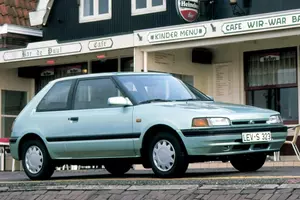
| Vehicle | Curb weight | Difference from world's smallest | Weight to power ratio | 0—60 mph acceleration ratio | Consumption ratio |
|---|---|---|---|---|---|
| 1.6 16V |
920 kg / 2029 lbs |
495 kg (1092 lbs) heavier | 10 kg to 1 hp | 80 kg/s (176 lbs/s) |
153 kg/L (337 lbs/L) |
| Vehicle | 1.6 16V |
|---|---|
| Curb weight |
920 kg / 2029 lbs |
| Difference from world's smallest | 495 kg (495 lbs) heavier |
| Weight to power ratio | 10 kg to 1 hp |
| 0—60 mph acceleration ratio | 80 kg/s (176 lbs/s) |
| Consumption ratio |
153 kg/L (337 lbs/L) |
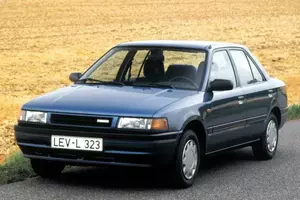
| Vehicle | Curb weight | Difference from world's smallest | Weight to power ratio | 0—60 mph acceleration ratio | Consumption ratio |
|---|---|---|---|---|---|
| 1.6 16V |
990 kg / 2183 lbs |
565 kg (1246 lbs) heavier | 11 kg to 1 hp | 93 kg/s (205 lbs/s) |
124 kg/L (273 lbs/L) |
| 1.8 16V |
1120 kg / 2470 lbs |
695 kg (1533 lbs) heavier | 11 kg to 1 hp | 144 kg/s (318 lbs/s) | - |
| 1.8 16V GT |
1120 kg / 2470 lbs |
695 kg (1533 lbs) heavier | 9 kg to 1 hp | 129 kg/s (284 lbs/s) | - |
| 1.8 4WD |
1120 kg / 2470 lbs |
695 kg (1533 lbs) heavier | 11 kg to 1 hp | 107 kg/s (236 lbs/s) |
149 kg/L (329 lbs/L) |
| 1.6 |
990 kg / 2183 lbs |
565 kg (1246 lbs) heavier | 12 kg to 1 hp | 93 kg/s (205 lbs/s) |
139 kg/L (306 lbs/L) |
| Vehicle | 1.6 16V |
|---|---|
| Curb weight |
990 kg / 2183 lbs |
| Difference from world's smallest | 565 kg (565 lbs) heavier |
| Weight to power ratio | 11 kg to 1 hp |
| 0—60 mph acceleration ratio | 93 kg/s (205 lbs/s) |
| Consumption ratio |
124 kg/L (273 lbs/L) |
| Vehicle | 1.8 16V |
| Curb weight |
1120 kg / 2470 lbs |
| Difference from world's smallest | 695 kg (695 lbs) heavier |
| Weight to power ratio | 11 kg to 1 hp |
| 0—60 mph acceleration ratio | 144 kg/s (318 lbs/s) |
| Consumption ratio | - |
| Vehicle | 1.8 16V GT |
| Curb weight |
1120 kg / 2470 lbs |
| Difference from world's smallest | 695 kg (695 lbs) heavier |
| Weight to power ratio | 9 kg to 1 hp |
| 0—60 mph acceleration ratio | 129 kg/s (284 lbs/s) |
| Consumption ratio | - |
| Vehicle | 1.8 4WD |
| Curb weight |
1120 kg / 2470 lbs |
| Difference from world's smallest | 695 kg (695 lbs) heavier |
| Weight to power ratio | 11 kg to 1 hp |
| 0—60 mph acceleration ratio | 107 kg/s (236 lbs/s) |
| Consumption ratio |
149 kg/L (329 lbs/L) |
| Vehicle | 1.6 |
| Curb weight |
990 kg / 2183 lbs |
| Difference from world's smallest | 565 kg (565 lbs) heavier |
| Weight to power ratio | 12 kg to 1 hp |
| 0—60 mph acceleration ratio | 93 kg/s (205 lbs/s) |
| Consumption ratio |
139 kg/L (306 lbs/L) |
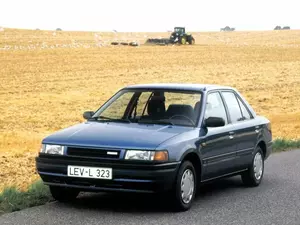
| Vehicle | Curb weight | Difference from world's smallest | Weight to power ratio | 0—60 mph acceleration ratio | Consumption ratio |
|---|---|---|---|---|---|
| 1.3 16V |
955 kg / 2106 lbs |
530 kg (1169 lbs) heavier | 13 kg to 1 hp | 90 kg/s (198 lbs/s) |
152 kg/L (335 lbs/L) |
| 1.6 |
995 kg / 2194 lbs |
570 kg (1257 lbs) heavier | 12 kg to 1 hp | 80 kg/s (176 lbs/s) |
120 kg/L (265 lbs/L) |
| Vehicle | 1.3 16V |
|---|---|
| Curb weight |
955 kg / 2106 lbs |
| Difference from world's smallest | 530 kg (530 lbs) heavier |
| Weight to power ratio | 13 kg to 1 hp |
| 0—60 mph acceleration ratio | 90 kg/s (198 lbs/s) |
| Consumption ratio |
152 kg/L (335 lbs/L) |
| Vehicle | 1.6 |
| Curb weight |
995 kg / 2194 lbs |
| Difference from world's smallest | 570 kg (570 lbs) heavier |
| Weight to power ratio | 12 kg to 1 hp |
| 0—60 mph acceleration ratio | 80 kg/s (176 lbs/s) |
| Consumption ratio |
120 kg/L (265 lbs/L) |